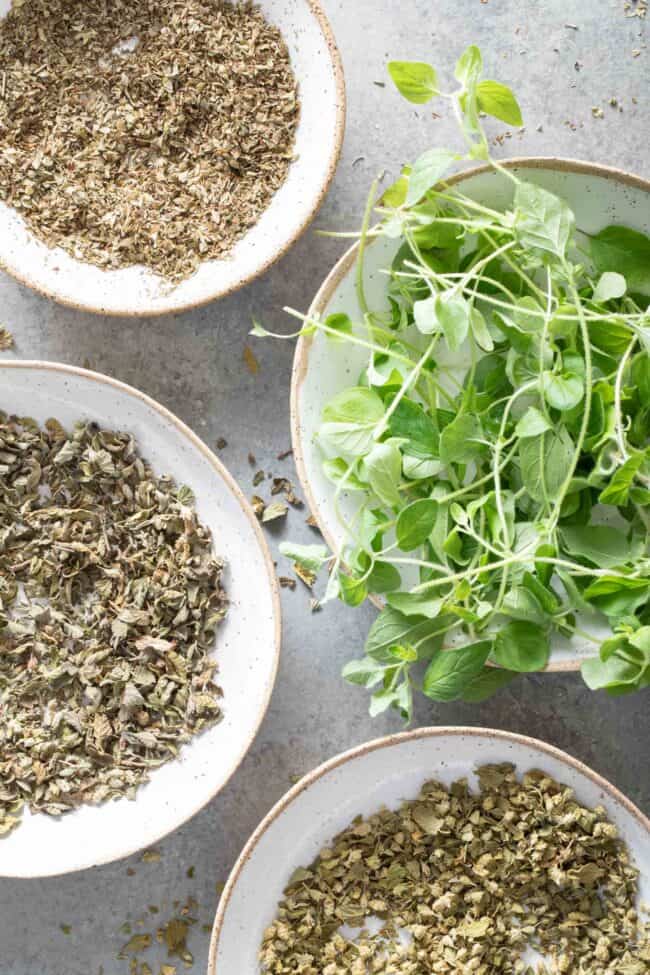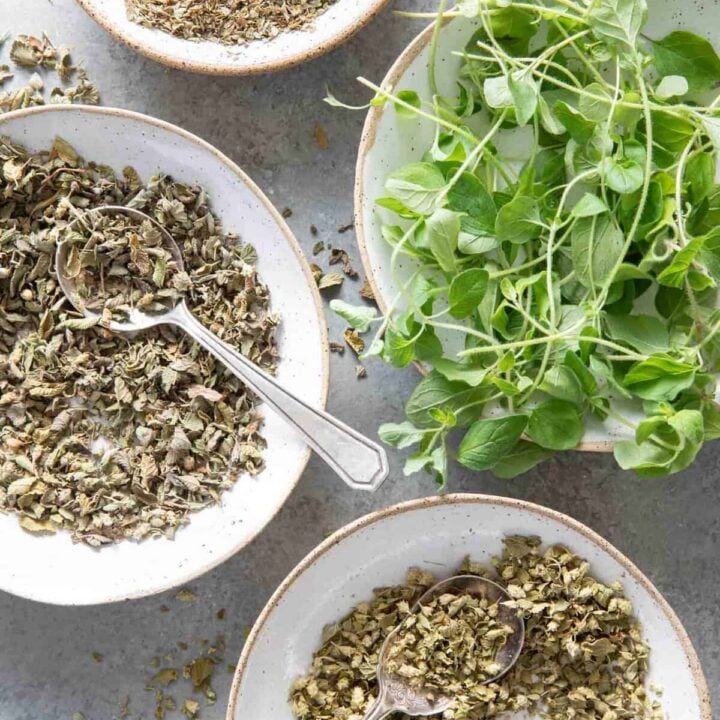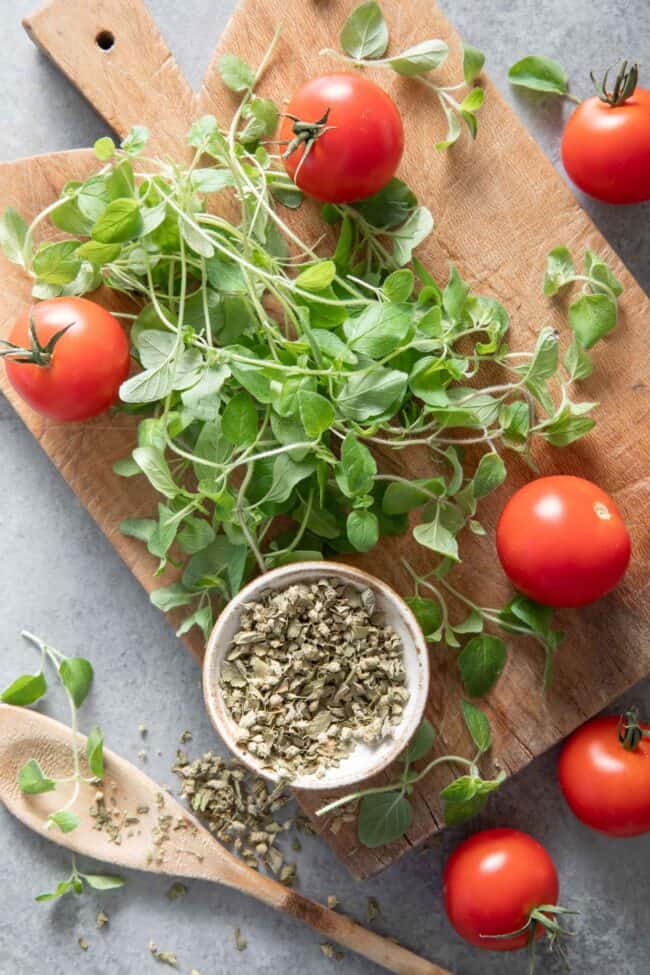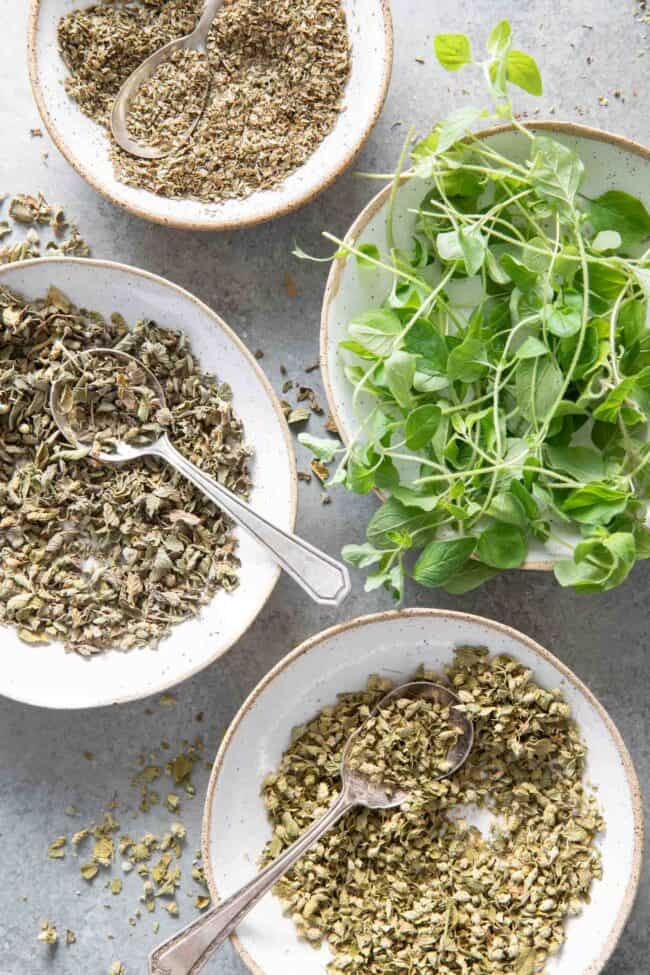Oregano Substitute
Need a good substitute for oregano? Oregano has a unique flavor that’s hard to replace. But if you’re in a pinch and need a replacement, here’s some of the best fresh oregano substitutes you can use.

If you’re making a recipe that calls for oregano and you don’t have any on hand, there’s a few substitutes you can use to replace it, like marjoram, basil, thyme and Italian seasoning, though the flavor won’t be quite the same.
What Is Oregano?
Oregano (Origanum vulgare which means “joy of the mountain in Greek) is actually Greek Oregano, but it is more commonly referred to as “oregano”, “common oregano”, “true oregano” and sometimes “wild marjoram”. It is a leafy green culinary herb from the Lamiaceae family (mint family) which includes spearmint, peppermint and basil. Fresh oregano is a fragrant herb with leaves that are used for seasoning a variety of dishes. It has a unique flavor with an earthy base and hints of pepper, menthol and lemon. It is a common herb used in Italian, Mediterranean, Greek, Turkish and Mexican cuisines.
Best Oregano Substitutes
1. Marjoram
Marjoram has a similar flavor profile as oregano, but it is more mild tasting. Use the same amount of marjoram as you would use for oregano (1:1 ratio) and adjust to taste. You may need to add a little more marjoram to your dish since oregano has a stronger flavor than marjoram.
2. Basil.
Basil has an earthy and slightly pepper flavor that is used in many of the same dishes as oregano. Even though it isn’t as sweet tasting as basil, it can be used as a substitution for basil in savory dishes like meats, sauces and salad dressings. Use the same amount of basil as you would use for oregano. (1:1 ratio)
3. Italian Seasoning
Italian seasoning makes a great substitute oregano (since oregano is one of the herbs typically found in Italian seasoning). Use 1/2 teaspoon Italian seasoning for every 1 teaspoon dried oregano, and adjust to taste.
4. Thyme
Thyme will work as a substitute for oregano if you’re using it as a garnish in Italian or Mediterranean dishes.
Varieties Of Oregano
- Mediterranean Oregano. Also referred to as common oregano and Greek Oregano is the most common type of oregano used.
- Italian Oregano. Italian Oregano has a flavor somewhere between oregano and marjoram and it’s often used to season pizza and pasta sauces.
- Cretan Oregano. This type of oregano is grown in Turkey, Greece and Italy and has a flavor similar to Greek oregano.
- Mexican Oregano. Mexican Oregano is a member of the lemon verbena family. It is typically grown in Mexico, as well as South America and Central America. It has has hints of citrus and undertones of licorice and is used in Mexican dishes like soups, stews, pozole, chilis, beans and sauces.
Marjoram vs Oregano
Marjoram (Origanum majorana) is also part of the mint family and is classified as a sub-species of oregano. In many Middle Eastern countries, marjoram is synonymous with “oregano”. It has a similar flavor profile as Greek oregano, but it is more mild and less spicy. Marjoram is commonly used in sauces, salad dressings and marinades.
Oregano vs Basil
Basil (Ocimum basilicum) is a leafy green culinary herb from the Lamiaceae family (mint family), which includes spearmint, peppermint and oregano. Oregano has an earthy and slight peppery flavor compared to basil’s minty and slightly sweet flavor. Even though their flavor profile is slightly different, they are both used in many of the same dishes (often tomato-based sauces).
Oregano vs Mexican Oregano
Mexican oregano comes from the same plant family as lemon verbena and Greek Oregano is a flowering herb that comes from the same family as mint and basil. Mexican oregano has hints of citrus and undertones of licorice and is used in Mexican dishes like soups, stews, pozole, chilis, beans and sauces. Greek oregano has an earthy and slightly peppery taste that brings warming flavors to Italian and Mediterranean dishes like soups, sauces, stews, vinaigrettes and marinades.
Fresh Oregano vs Dried Oregano
The flavor of fresh oregano and dried oregano are very similar. Dried oregano is typically used in many cuisines around the world and the ability to substitute fresh oregano with dried will depend on the type of dish you are cooking. Dried oregano can replace fresh oregano in many recipes, like sauces, dressings, soups and stews. To substitute fresh oregano with dried, use one-third the amount of dried as you would fresh. For example replace 1 tablespoon fresh oregano with 1 teaspoon of dried.
Should You Rinse Fresh Oregano Before Using It?
Fresh oregano should be rinsed under cool running water before adding to a dish. Allow excess water to drip off the leaves over the sink then either gently pat them dry using a paper towel or put the sprigs in a salad spinner to dry.
How Do You Store Fresh Oregano?
- Trim the stems and place the oregano in a glass of water with a plastic bag covering the leaves. Store either on the countertop or the refrigerator if you have the space.
- Lay the stems flat on a damp paper towel. Roll the paper towel up and put in a plastic bag and store in the refrigerator.
- Pluck the leaves off the stems and place in a freezer storage bag and lay flat in the freezer until the leaves are frozen.
How Do You Cook With Oregano?
Rub dried oregano between your fingers to release the essential oils before cooking with it and chop fresh oregano to release these oils before adding it to a dish. Dried oregano is more commonly used in cooking and fresh oregano is typically added at the end of cooking a dish or it is used as a garnish. Oregano is commonly used to season vegetables, grilled chicken and fish, tomato sauces, marinades and salad dressings.
Recipes Using Oregano
More Resources
- Lemon Juice Substitute
- Brown Sugar Substitute
- Creme Fraiche Substitute
- Parchment Paper Substitute
- Bay Leaf Substitute
- Rosemary Substitute
- Mint Substitute
- Cilantro Substitute
- Tomato Sauce Substitute
- Tomato Paste Substitute
- How Much Juice in One Lime
- How Much Juice in One Lemon
- How to Zest a Lemon
- How to Freeze Spinach

Oregano Substitute
Need a good substitute for oregano? Oregano has a unique flavor that’s hard to replace. But if you’re in a pinch and need a replacement, here’s some of the best fresh oregano substitutes you can use.
Ingredients
- Marjoram
- Basil
- Italian Seasoning
- Thyme
Instructions
- Marjoram. Use the same amount of marjoram as you would use for oregano (1:1 ratio) and adjust to taste. You may need to add a little more marjoram to your dish since marjoram has a more mild flavor than oregano.
- Basil. Use the same amount of oregano as you would use for oregano. (1:1 ratio)
- Italian Seasoning. Use 1/2 teaspoon Italian seasoning for every 1 teaspoon dried oregano called for in a recipe, and adjust to taste.
- Thyme. Thyme will work as a substitute for oregano if you're using it as a garnish in Italian or Mediterranean dishes. Use the same amount of thyme as a garnish as you would use for oregano. (1:1 ratio)
Notes
Fresh Oregano vs Dried Oregano
The flavor of fresh oregano and dried oregano are very similar. Dried oregano is typically used in many cuisines around the world and the ability to substitute fresh oregano with dried will depend on the type of dish you are cooking. Dried oregano can replace fresh oregano in many recipes, like sauces, dressings, soups and stews. To substitute fresh oregano with dried, use one-third the amount of dried as you would fresh. For example replace 1 tablespoon fresh oregano with 1 teaspoon of dried.
How Do You Cook With Oregano?
Rub dried oregano between your fingers to release the essential oils before cooking with it and chop fresh oregano to release these oils before adding it to a dish. Dried oregano is more commonly used in cooking and fresh oregano is typically added at the end of cooking a dish or it is used as a garnish. Oregano is commonly used to season vegetables, grilled chicken and fish, tomato sauces, marinades and salad dressings.
Nutrition Information:
Yield:
1Serving Size:
1Amount Per Serving: Calories: 18Total Fat: 1gSaturated Fat: 0gTrans Fat: 0gUnsaturated Fat: 0gCholesterol: 0mgSodium: 3mgCarbohydrates: 4gFiber: 2gSugar: 0gProtein: 1g
theharvestkitchen.com attempts to provide accurate information, however, this nutritional information is provided as a courtesy and is an estimate only. The nutritional information provided comes from online sources and calculations. See full disclaimer on About page.



